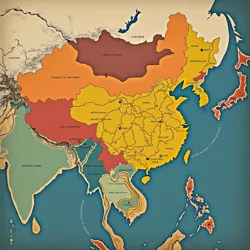Age of Distended Sovereignties

Jade Lands during the Age of Distended Sovereignties, a period marked by independent states and cultural growth.
Age of Distended Sovereignties
Zheng Era
14
18
Ten Kingdoms Era
Western Intrusion
Warring States period of China
consolidation of power into states
The Age of Distended Sovereignties (爭國時代, Zhēng Guó Shídài), also known as the Epoch of Fiefdom Rivalry or simply the Zheng Era (爭 Era), marks a significant period in the history of the Jade Lands, spanning from the 14th to the 18th centuries. This era followed the tumultuous Ten Kingdoms Era and preceded the disruptive Western Intrusion. Characterized by the consolidation of power into several major independent states after the fragmentation of the Yuan Dynasty (元朝, Yuán Cháo), the Age of Distended Sovereignties was a time of intense geopolitical maneuvering, frequent warfare, vibrant economic expansion, and remarkable cultural and intellectual development across the Jade Lands. This epoch is often compared to the Warring States period of ancient China or the system of competing nation-states that emerged in early modern Europe, due to its dynamic balance of power, shifting alliances, and pervasive inter-state competition.
Political Structures and Statecraft
Emergence of Major Polities
 Regional powers solidify control after the Yuan Dynasty collapse, leading to the formation of states like Liang-Ning and Yong-An.
Regional powers solidify control after the Yuan Dynasty collapse, leading to the formation of states like Liang-Ning and Yong-An.The 14th century saw the gradual decline and expulsion of Yuan Dynasty rule from the Jade Lands. While the Yuan had briefly imposed a semblance of unity, their dominion was ultimately unsustainable due to a combination of internal rebellions and resistance from the diverse populations of the Jade Lands. Following the Yuan collapse, no single power was able to re-establish centralized imperial authority. Instead, several regional powers, many tracing their origins back to the jiedushi of the late Tang Dynasty, solidified their control and expanded their territories.
By the beginning of the Age of Distended Sovereignties, a relatively stable constellation of states had emerged. These included:
- Liang-Ning (梁寧, Liángníng): Situated in the northern plains, Liang-Ning inherited a strong military tradition and controlled strategic access to the northern steppes. Its rulers emphasized pragmatic governance and military strength, often engaging in campaigns against nomadic groups and rival Jade Lands states. Liangning City served as its imposing capital.
- Yong-An (永安, Yǒng'ān): Located in the fertile central river valleys, Yong-An positioned itself as the cultural and political successor to the Tang Dynasty. Yonganese rulers promoted Confucianism and invested heavily in the arts, seeking to project an image of refined legitimacy and attract talent from across the Jade Lands. Its capital, Yongan, became renowned for its scholarship and artistic patronage.
- Jing-Hua (京華, Jīnghuá): Dominating the eastern coastline, Jing-Hua became a major maritime power, leveraging its access to sea trade routes to amass wealth and influence. Jinghuanese society was characterized by its cosmopolitanism, commercial dynamism, and openness to outside influences. Jinghua, its bustling port city capital, stood as a testament to its maritime prowess.
- Shu-Han (蜀漢, Shǔhàn): Nestled in the Sichuan Basin, Shu-Han benefited from its natural defenses and fertile lands, allowing it to maintain a degree of isolation and cultivate a unique regional culture. Shuhanese rulers often pursued a policy of neutrality in inter-state conflicts, focusing on internal development and artistic pursuits. Shuhan, its capital, became known for its distinctive cuisine and artistic traditions.
- Min-Yue (閩越, Mǐnyuè) and Wu-Yue (吳越, Wúyuè): These southeastern coastal kingdoms continued their maritime traditions, often competing with Jing-Hua and each other for control of trade routes and coastal resources. They possessed distinct regional cultures and languages, contributing to the rich tapestry of the Jade Lands. Yuejing (越京, Yuèjīng) and Wujing (吳京, Wújīng) served as their respective capitals, centers of maritime commerce and local identity.
- Yan-Zhao (燕趙, Yānzhào), Qi-Lu (齊魯, Qílǔ), and Jin-Wei (晉衛, Jìnwèi): These states, located in the northern and western peripheries of the Jade Lands proper, played significant roles in regional power dynamics, often acting as buffer zones or contested territories between the major kingdoms. Yan-Zhao, known for its cavalry, bordered the northern steppes. Qi-Lu, on the Shandong peninsula, was fertile and philosophically inclined. Jin-Wei, in the Shanxi region, possessed valuable mineral resources. Zhaojing (趙京, Zhàojīng), Linzi (臨淄, Línzī), and Taiyuan (太原, Tàiyuán) were their respective capitals, each with unique regional characteristics.
These states, while distinct, shared a common cultural heritage rooted in the Concordian Way and a shared history. They also recognized, to varying degrees, the spiritual authority of the Mount Hua Holy See. However, these commonalities did not prevent frequent conflicts and intense competition for resources, territory, and prestige.
Zheng Era Diplomacy and Warfare
Inter-state relations during the Age of Distended Sovereignties were characterized by a complex interplay of diplomacy, alliance formation, and warfare. No single state was powerful enough to dominate the others for an extended period, leading to a dynamic balance of power. States constantly shifted alliances, engaging in intricate diplomatic maneuvering to gain advantage or prevent the rise of a hegemon. This era witnessed the development of sophisticated diplomatic practices, which might be termed Zheng Era Diplomacy (爭國外交, Zhēng Guó Wàijiāo).
Key features of Zheng Era Diplomacy included:
- Multi-lateral Alliances: States frequently formed temporary alliances to counter specific threats or achieve short-term objectives. These alliances were often fluid and opportunistic, shifting based on changing circumstances and perceived interests. Examples include coalitions formed to check the expansion of Liang-Ning or alliances between southern maritime states to counter inland powers.
- Hostage Systems and Royal Marriages: To ensure the reliability of alliances and prevent betrayal, states often exchanged royal hostages or arranged strategic marriages between ruling families. These practices, while not always foolproof, were intended to create personal and familial bonds that would reinforce political agreements.
- Tribute and Subsidies: Weaker states often paid tribute or subsidies to stronger neighbors to maintain peace or secure protection. These payments could be a significant drain on state resources but were sometimes seen as a necessary cost for survival. Conversely, stronger states might offer subsidies to allies to maintain their loyalty or encourage them to act against rivals.
- Espionage and Intelligence Gathering: Given the constant state of competition, espionage and intelligence gathering became crucial aspects of statecraft. States invested heavily in networks of spies and informants to monitor the activities of rivals, assess their military strength, and uncover diplomatic secrets.
- Ritual and Protocol: Despite the frequent conflicts, inter-state diplomacy was also governed by elaborate rituals and protocols, often rooted in the principles of Ritual and Ceremony within the Concordian Way. These protocols aimed to establish a framework for communication and negotiation, even between hostile states, and to project an image of civilized conduct in a turbulent era.
Warfare during the Age of Distended Sovereignties was frequent but rarely decisive. States maintained standing armies and invested in fortifications, but prolonged campaigns were costly and often yielded limited gains. Military technology advanced gradually during this period, with improvements in siegecraft, cavalry tactics, and naval warfare. However, the decentralized nature of the Jade Lands and the resilience of individual states meant that conquest was difficult and rarely resulted in lasting unification. Conflicts often revolved around control of strategic resources, such as fertile land, river systems (Liang River, Yong River, Jing River), or trade routes.
The Role of the Mount Hua Holy See
The Mount Hua Holy See, under the leadership of the Harmonious Pontiff, played a unique and influential role in the political landscape of the Age of Distended Sovereignties. While not a territorial state in the conventional sense, the Holy See wielded significant religious, cultural, and even political power across the Jade Lands.
Its influence stemmed from several factors:
- Spiritual Authority: As the central institution of the Concordian Way, the Holy See was recognized as the ultimate arbiter of religious doctrine and practice. The Harmonious Pontiff's pronouncements on matters of faith and morality carried considerable weight among rulers and common people alike.
- Moral Legitimacy: The Concordian Way emphasized Harmonious Concord and social order. The Holy See positioned itself as a guardian of these principles, offering moral guidance to rulers and mediating disputes between states. Its pronouncements could influence public opinion and legitimize or delegitimize political actions.
- Economic Power: The Holy See controlled vast landholdings, monasteries, and other economic assets across the Jade Lands. This economic power gave it financial independence and allowed it to act as a significant economic actor in its own right. Monasteries affiliated with the Holy See were often centers of agricultural production, trade, and even banking.
- Diplomatic Mediation: Due to its neutral position and widespread respect, the Holy See frequently acted as a mediator in inter-state conflicts. The Harmonious Pontiff and his envoys could facilitate negotiations, broker truces, and promote peaceful resolutions to disputes. While not always successful, these mediation efforts often helped to prevent conflicts from escalating and contributed to regional stability.
- Cultural Unity: The Concordian Way provided a shared cultural framework across the Jade Lands, even amidst political fragmentation. The Holy See, as the custodian of this tradition, fostered a sense of pan-Jade Lands cultural identity, transcending political boundaries. This cultural unity provided a basis for cooperation and communication, even between rival states.
The Holy See's influence was not absolute, and individual states often pursued their own interests, even when they conflicted with the Holy See's pronouncements. However, the Holy See remained a significant force in Zheng Era politics, acting as a unique blend of religious authority, moral arbiter, and diplomatic mediator, contributing to the distinctive character of this era.
Economic Dynamism and Social Change
Flourishing Trade and Commerce
 Maritime trade expands and Silk Roads revitalize, fostering economic growth and urban development across the Jade Lands.
Maritime trade expands and Silk Roads revitalize, fostering economic growth and urban development across the Jade Lands.The Age of Distended Sovereignties was a period of remarkable economic expansion in the Jade Lands. Despite the frequent warfare, trade and commerce flourished, both within the region and with neighboring areas. The fragmentation of political power, while creating instability in some respects, also fostered economic competition and innovation. States vied to attract merchants, artisans, and skilled laborers, offering favorable trade policies and investing in infrastructure.
Key economic developments included:
- Expansion of Maritime Trade: Coastal states like Jing-Hua, Min-Yue, and Wu-Yue experienced significant growth in maritime trade. They established extensive trading networks across Southeast Asia, the Indian Ocean, and even into the western seas. Jinghuanese merchants, in particular, became renowned for their entrepreneurial spirit and far-reaching commercial activities.
- Revitalization of the Silk Roads: While maritime trade expanded, overland trade along the Silk Roads also remained important. The Jade Lands served as a crucial link in these transcontinental trade routes, connecting East Asia with Central Asia, Persia, and beyond. States like Liang-Ning and Jin-Wei benefited from their strategic location along these routes.
- Growth of Urban Centers: Cities like Liangning City, Yongan, Jinghua, and Shuhan experienced significant population growth and economic diversification. They became centers of manufacturing, craftsmanship, trade, and consumption. Urban markets offered a wide variety of goods, both locally produced and imported from distant lands.
- Development of Internal Markets: Improvements in transportation infrastructure, such as roads and canals, facilitated the growth of internal markets within the Jade Lands. Regional specialization of production emerged, with different areas focusing on particular crops, crafts, or industries. This internal trade network contributed to overall economic integration and prosperity.
- Emergence of Merchant Guilds and Associations: To regulate trade, protect their interests, and manage risks, merchants increasingly formed guilds and associations. These organizations played a significant role in shaping economic policies, negotiating with state authorities, and fostering commercial networks.
This economic dynamism led to increased wealth accumulation, social mobility, and urbanization. However, it also created new social tensions and inequalities. The growing merchant class gained economic and social influence, sometimes challenging the traditional dominance of the landed gentry and bureaucratic elites.
Agricultural Innovations and Industrial Growth
Agriculture remained the foundation of the Jade Lands economy during the Age of Distended Sovereignties. Significant agricultural innovations contributed to increased productivity and food surpluses, supporting population growth and economic diversification.
These innovations included:
- Improved Irrigation Techniques: States invested in developing and expanding irrigation systems, including canals, reservoirs, and water wheels. These improvements allowed for more efficient water management and increased agricultural yields, particularly in rice cultivation.
- New Crop Varieties: The introduction and cultivation of new crop varieties, such as drought-resistant grains and fast-ripening rice strains, further enhanced agricultural productivity and allowed for cultivation in previously marginal lands.
- Agricultural Tools and Techniques: Gradual improvements in agricultural tools and techniques, such as the use of iron plows, seed drills, and fertilizers, contributed to increased efficiency and output.
- Land Reclamation and Expansion: Efforts were made to reclaim land for agriculture through drainage of wetlands, terracing of hillsides, and expansion into previously uncultivated areas.
Alongside agricultural advancements, the Age of Distended Sovereignties also witnessed the nascent stages of industrial growth in certain sectors. While not comparable to the later industrial revolutions in the West, these developments laid the groundwork for future industrialization.
Key industrial activities included:
- Textile Production: Silk, cotton, and hemp textiles remained major industries, with centers of production located in various regions of the Jade Lands. Technological improvements, such as the development of more efficient looms and spinning techniques, increased output and quality.
- Ceramics and Porcelain: The Jade Lands were renowned for their ceramics and porcelain production, particularly in Jing-Hua and Yong-An. These goods were highly sought after both domestically and in foreign markets. Technological advancements in kiln technology and glazing techniques led to further refinement of these industries.
- Metalworking and Mining: Mining of iron, copper, and other metals expanded during this period, supporting the production of tools, weapons, and other metal goods. Jin-Wei, in particular, was known for its iron and coal resources. Improvements in mining techniques and metalworking processes gradually increased production capacity.
- Shipbuilding: Coastal states like Jing-Hua, Min-Yue, and Wu-Yue developed sophisticated shipbuilding industries to support their maritime trade and naval power. Shipbuilding technology advanced, with larger and more seaworthy vessels being constructed.
These economic developments, while fostering prosperity and social change, also contributed to environmental pressures, such as deforestation, soil erosion, and water pollution, foreshadowing challenges that would become more pronounced in later periods.
Cultural and Intellectual Flourishing
Artistic and Literary Achievements
 Arts and literature flourish with calligraphy, painting, poetry, and opera reflecting regional diversity and common culture.
Arts and literature flourish with calligraphy, painting, poetry, and opera reflecting regional diversity and common culture.The Age of Distended Sovereignties was a golden age for arts and literature in the Jade Lands. Despite the political fragmentation and frequent warfare, cultural creativity flourished, reflecting both regional diversity and pan-Jade Lands commonalities. Patronage from state rulers, wealthy merchants, and religious institutions supported artistic and literary endeavors.
Notable artistic and literary forms included:
- Calligraphy and Painting: Calligraphy and painting remained highly valued art forms, with distinctive regional styles emerging in different states. Landscape painting, portraiture, and narrative painting all flourished. New techniques and styles were developed, pushing the boundaries of artistic expression.
- Poetry and Literature: Poetry continued to be a central form of literary expression, with diverse styles and themes. Lyric poetry, narrative poems, and philosophical verse were all popular. Prose literature also developed, including historical chronicles, philosophical treatises, and vernacular fiction.
- Opera and Performing Arts: Regional forms of opera and performing arts gained popularity, blending music, dance, drama, and acrobatics. These performances provided entertainment for both elite and popular audiences and often incorporated elements of local folklore and history.
- Architecture and Gardens: States invested in constructing grand palaces, temples, and public buildings, reflecting their power and cultural aspirations. Garden design became a refined art form, blending natural landscapes with architectural elements to create harmonious and aesthetically pleasing spaces.
These artistic and literary achievements reflected the diverse cultural influences within the Jade Lands, drawing inspiration from the Concordian Way, Confucianism, Buddhism, and local traditions. They also showcased the dynamism and creativity of Zheng Era society.
Philosophical and Religious Developments
The Concordian Way continued to evolve and diversify during the Age of Distended Sovereignties. While the Mount Hua Holy See served as the central religious authority, diverse schools of thought and practice emerged within the Concordian tradition.
Key developments included:
- Institutionalization of the Concordian Way: The Holy See consolidated its institutional structure, developing monastic orders, educational institutions, and administrative systems. This institutionalization helped to standardize religious practices and doctrines across the Jade Lands.
- Diversification of Concordian Thought: Different schools of thought within the Concordian Way emphasized different aspects of its teachings, such as Moral Cultivation, Ritual and Ceremony, or philosophical inquiry. Soul-Gardening emerged as a distinct contemplative practice focusing on inner harmony and spiritual refinement.
- Syncretism and Local Adaptations: The Concordian Way continued to interact with local beliefs and practices, leading to syncretic forms of religious expression in different regions. Ancestral Veneration remained a central aspect of religious life, often integrated with Concordian rituals and beliefs.
- Intellectual Debates and Philosophical Inquiry: Scholars and thinkers engaged in lively debates on philosophical and religious issues, exploring the meaning of Harmonious Concord, the nature of Ancestral Veneration, and the Mandate of Heaven. These intellectual exchanges contributed to the ongoing evolution of Concordian thought.
While the Concordian Way remained dominant, other religious and philosophical traditions, such as Buddhism and Daoism, continued to exist and exert influence in certain regions. The religious landscape of the Jade Lands remained diverse and dynamic, reflecting the broader cultural pluralism of the era.
Language and Scholarship
The Age of Distended Sovereignties witnessed further linguistic diversification within the Jade Lands. While all languages were descended from Old Zhongyuan, regional dialects continued to diverge, evolving into distinct languages within the Zhongyuan language family.
Key linguistic developments included:
- Emergence of Vernacular Languages: Vernacular forms of languages, such as Liangningese language, Yonganese language, Jinghuanese language, and Shuhanese language, became increasingly distinct from classical literary language. These vernacular languages were used in popular culture, commerce, and everyday communication.
- Yonganese as Lingua Franca: Despite linguistic diversification, Yonganese, based on the classical language of the Tang Dynasty, became increasingly recognized as the lingua franca of the Jade Lands. It was widely used in diplomacy, trade, scholarship, and inter-state communication.
- Development of Regional Literary Traditions: While classical Yonganese remained prestigious, regional literary traditions also developed in vernacular languages. These traditions reflected local cultural identities and contributed to the rich literary landscape of the Jade Lands.
- Expansion of Education and Literacy: Efforts were made to expand education and literacy, both by state institutions and religious organizations. Literacy rates gradually increased, particularly in urban centers, contributing to the spread of knowledge and cultural exchange.
Scholarship flourished during this era, encompassing a wide range of disciplines, including history, philosophy, literature, mathematics, astronomy, and medicine. Scholarly academies and libraries were established, supported by state patronage and private funding. The pursuit of knowledge and learning was highly valued, contributing to the intellectual vibrancy of the Age of Distended Sovereignties.
External Interactions
Relations with Islamic States
The Jade Lands maintained complex and multifaceted relations with the Islamic states to their west, including the Samarkand Sultanate and the Ferghana Khanate. These relations were characterized by a mixture of trade, diplomacy, cultural exchange, and occasional conflict.
Key aspects of these interactions included:
- Silk Road Trade: The Silk Roads continued to serve as vital arteries for trade between the Jade Lands and the Islamic world. Goods, ideas, and cultural influences flowed in both directions. Jade Lands merchants traded silk, porcelain, tea, and other goods westward, while Islamic merchants brought spices, textiles, horses, and precious metals eastward.
- Diplomatic Exchanges: States in the Jade Lands and Islamic polities engaged in diplomatic exchanges, sending embassies and negotiating treaties. These diplomatic interactions aimed to regulate trade, resolve border disputes, and manage political relations.
- Cultural and Intellectual Exchange: Scholars, travelers, and religious figures moved between the Jade Lands and the Islamic world, facilitating cultural and intellectual exchange. Islamic astronomy, mathematics, and medicine were introduced to the Jade Lands, while aspects of Concordian philosophy and Jade Lands art influenced intellectual circles in the Islamic world.
- Border Conflicts and Rivalries: Despite trade and diplomacy, border conflicts and rivalries occasionally erupted between Jade Lands states and Islamic polities. These conflicts often stemmed from territorial disputes, competition for resources, or religious differences. However, large-scale wars were relatively infrequent.
- Treaty of Heavenly Mountains: Towards the end of the Age of Distended Sovereignties, the Treaty of Heavenly Mountains was signed, formally demarcating the border between the Jade Lands and the Islamic states in the western regions. This treaty aimed to stabilize relations and prevent future conflicts, but cross-border interactions continued to shape regional dynamics.
Early Western Encounters
Towards the end of the Age of Distended Sovereignties, the Jade Lands began to experience initial encounters with Western powers. These early contacts were tentative and limited, primarily involving exploratory voyages and trade missions from Western nations seeking access to Jade Lands markets.
These early encounters foreshadowed the more intense and disruptive Western Intrusion of the 19th and 20th centuries. However, during the Age of Distended Sovereignties, Western influence remained marginal, and the Jade Lands largely maintained its internal focus and regional orientation. The seeds of future transformation, however, were being sown as the world beyond the Jade Lands began to exert its influence.